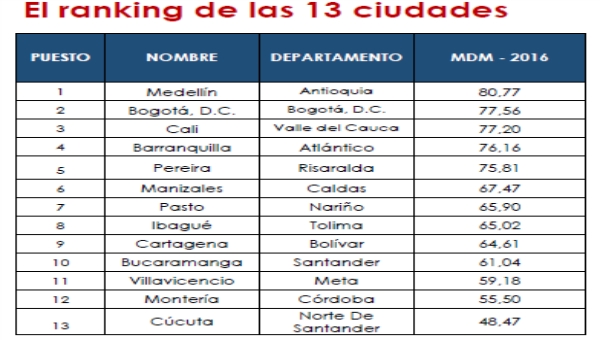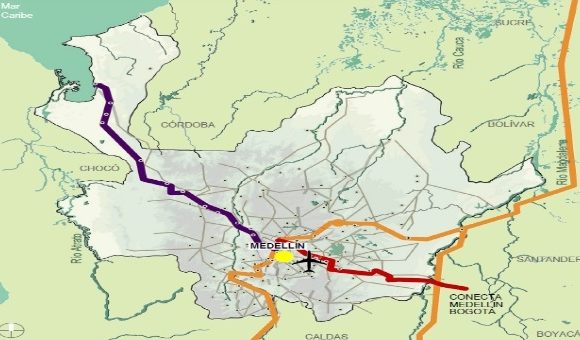Colombia National Agency Ranks Medellin #1 in Government Planning, Execution

Colombia’s national planning agency — Departamento Nacional de Planeacion (DNP) — on December 5 announced that the city of Medellin ranks best among Colombia’s 13 biggest cities for government planning and execution.
While Medellín took the top spot in the ranking of Colombia’s biggest cities, Bogotá came in second, followed by Barranquilla, Cali, Pereira, Manizales, Pasto, Ibague, Cartagena, Bucaramanga, Villavicencio, Monteria and Cucuta (see chart, above).
Three of the top-five mid-sized cities in the DNP study also are in Antioquia: Rionegro, Envigado and La Estrella, along with Girardot and Mosquera (the latter two both in Cundinamarca).
“The report highlights those municipalities that, starting from similar initial capacities, achieve good management and better development results — that is, increasing the quality of life of the population is the ultimate goal of public management at the local level,” according to DNP.
“After 10 years of measuring ‘Integral Performance,’ the DNP has updated this indicator and launches the ‘New Municipal Performance’ measurement, an index that evaluates the new challenges of local administrations and for the first time measures results-oriented management.”
“This new measurement seeks to be a useful instrument for the design of policies aimed at strengthening the capacities of territorial entities, in such a way that results-oriented investment is encouraged and we achieve the closing of gaps at the territorial level,” added DNP acting director Juan Felipe Quintero Villa.
The ranking system grouped “homogeneous” municipalities, “taking into account the existing differences in their capacity levels with the resources they have, as well as their level of rurality,” according to DNP.
The agency measured capacities of 1,101 municipalities, classified into six groups: Large cities (13 main cities); Group 1 (high level of capabilities); Group 2 (medium high); Group 3 (middle level); Group 4 (medium low) and Group 5 (low level).
“The measurement takes into account variables such as the effort of the municipalities to generate their own resources, quality in the execution of resources by different sources, conditions of open government and transparency, as well as the use of territorial ordering instruments in the collection,” according to DNP.
The study also analyzed city planning and management of education, health, access to public services, security and citizen coexistence.
Mobilization of resources and land management instruments “are the main management challenges of the municipalities,” according to the agency.
City managers could improve their rankings via updating of real-estate cadastre and land use planning, “as well as using other instruments such as surplus value, urban delineation and valorization,” said Quintero Villa.
“At the national level, only 4% of the municipalities of the country make use of three or four land management instruments to increase [property tax] collection, while almost 96% of the country uses two or less,” according to DNP.
Meanwhile, “big gaps are seen in education and public services. While on average the net [public education] coverage of the 13 main cities is 50%, the average coverage in the municipalities of ‘Group 5’ is 28%. Investments in educational infrastructure and teacher training are essential,” according to DNP.
For the biggest cities, the bigger challenge is “security and coexistence,” DNP added.
















